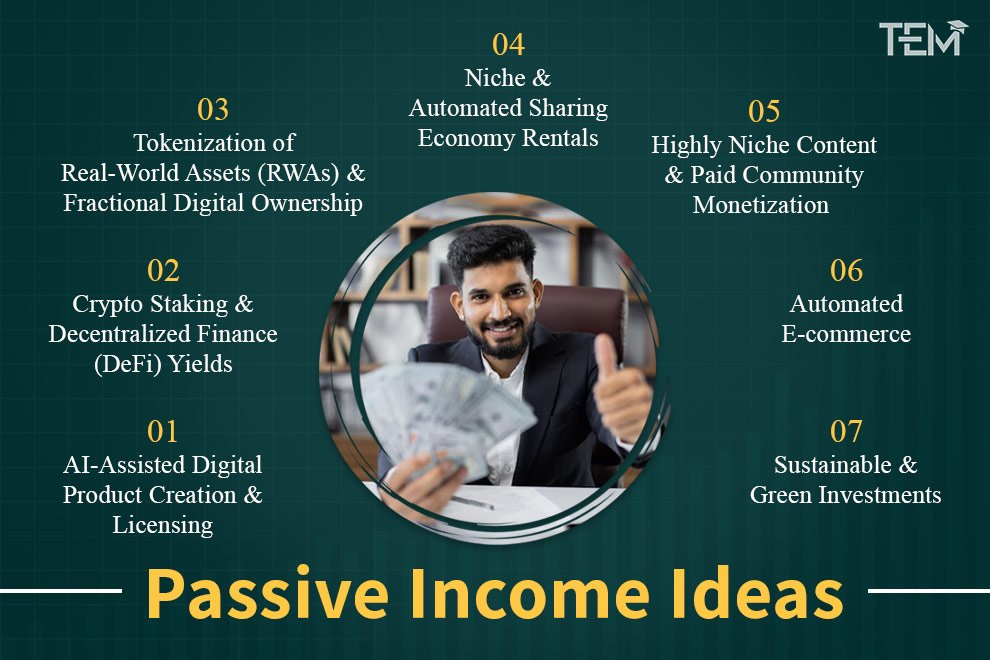Building passive income is smart. It helps you gain financial freedom. You earn money without daily work. This creates stability for your future. However, the world keeps changing fast. New technologies emerge daily. Global markets shift constantly. So, old ways may not be enough. We must look ahead to 2025. You need passive income ideas that truly last. This means choosing high-demand methods. They use new technologies. They fit current market needs. This guide will show you how. We explore top strategies. We focus on modern opportunities. Learn how to grow your wealth. Discover smart financial moves for tomorrow.
Why Focus on “High-Demand” Passive Income for the Future?
Why should I choose new passive income ideas now?
Looking at new passive income ideas is smart. It helps your money grow. Old ways might not show all chances. New tech and global markets change things.
Staying Ahead of the Curve
Why look beyond old passive income ways?
Old lists often show classic methods. Think of rental homes. Or maybe dividend stocks. Selling digital products is also common. These ways still work. But they do not show all new chances. New tech changes fast. Current market trends are important.
For example, old methods might miss new areas. AI helps create digital products fast. Decentralized finance (DeFi) is also new. Tokenization of real assets grows quickly. These new ways offer more. They grow faster. They work better. They fit today’s digital world. Sticking to old ways limits you. It reduces new income sources. You might miss big growth. Your money feels safer in a changing world.
Leveraging Emerging Technologies
How do new technologies help me earn passively?
New tech changes how we make money. AI, blockchain, and automation are key. They make passive income ideas bigger. They offer many more options.
- AI Helps You: AI cuts time to create. It lowers costs too. Think of digital products. It automates marketing. It helps customer support. It also makes niche content. You need little money to start. You can make more money easily.
- Blockchain Power: Blockchain supports new finance. It helps with crypto staking. You can lend money. You can also farm for gains. These ways are clear and safe. It also turns real things into digital tokens. Like real estate or art. You can trade these easily. More people can now invest.
- Smart Automation: Automation makes work easy. It helps online shops like dropshipping. It also helps print-on-demand. It shares content widely. It keeps people engaged. This means less work for you. It also means more profit.
These technologies create new chances. They make passive income dynamic. It becomes bigger. It is easier to start. Often, you need less initial money.
Global Accessibility
Can anyone around the world earn passive income this way?
Yes, digital passive income ideas reach everyone. New tech helps this. People everywhere can join easily. This includes the USA.
- Reach More Markets: Digital platforms connect everyone. Blockchain allows easy trade. You can invest across borders. USA investors can join DeFi. They can buy global digital assets. This helps spread out money. It also brings more chances.
- Help Small Investors: Fractional ownership lowers costs. You can own a piece of big things. This was once only for rich groups. Now, smaller investors can join. They can access high-value assets.
- USA’s Strong Base: The USA has good tech. It has wide internet access. Rules are also getting clearer. This is true for crypto. It helps more people join. It builds trust.
- New Market Growth: The USA leads in new ideas. But these trends also help people in other countries. They get new income chances. This helps everyone build wealth.
The Top 7 Passive Income Ideas Poised for Growth in 2025
- AI-Assisted Digital Product Creation & Licensing
- Crypto Staking & Decentralized Finance (DeFi) Yields
- Tokenization of Real-World Assets (RWAs) & Fractional Digital Ownership
- Niche & Automated Sharing Economy Rentals
- Highly Niche Content & Paid Community Monetization
- Automated E-commerce
- Sustainable & Green Investments
1. AI-Assisted Digital Product Creation & Licensing
This uses smart AI tools. They help you make digital items. These include e-books and online courses. You can also create digital art. Templates and music are options too. Then, you license or sell these items. You get money again and again. AI greatly cuts production time. It lowers creation costs too. Thus, anyone can make good digital products. You do not need deep tech skills.
What digital products can AI help create?
- E-books and Workbooks: AI writing tools help here. They draft content for you. They make outlines. They edit and format text. This creates good written products.
- Online Courses and Guides: Tools like Descript help scripting. Heights AI builds lessons. They speed up course making.
- Digital Art and Graphics: AI image makers help a lot. Midjourney and Adobe Firefly create visuals quickly. Use them for art or ads.
- Music and Sounds: Suno.ai crafts new music. AI makes sounds for you. These fit specific styles.
- Templates and Brands: AI helps design tools. You make custom templates. You can also build logos easily. This gives more people design power.
You can also license these products. Master Resell Rights (MRR) let others sell them. This brings you more money.
Why is this a top passive income idea for 2025?
Demand for these items is soaring in 2025. Many things drive this growth.
- Faster and Cheaper: AI tools automate tasks. They make product creation 10 times faster. They cut costs by 30% to 70%. This beats old ways.
- Easy for Everyone: These tools remove barriers. Anyone can make polished digital goods. You do not need many skills.
- Big Market Growth: The global market for AI content creation grows fast. Experts set its size at $14.84 billion in 2024. They expect it to grow by 32.5% each year through 2030.
- More Money Invested: About 90% of groups invest in AI. Also, 67% expand their AI investments. They boost work output.
- People Want It: Around 80% of people surveyed will try AI products. This shows a big market is ready.
This changes creative fields. It also impacts marketing. AI speeds up new ideas. It helps personalize things widely.
How to Get Started (Brief Overview)
- Find Your Niche: Pick a market you like. Think about your skills. Is there high demand for products there?
- Choose AI Tools: Use specific AI tools. Pick ones for your product. For text, use ChatGPT. For visuals, try Midjourney. Suno.ai helps with audio.
- Pick Selling Platforms: Sell on Gumroad. Or use Etsy. Your own website works too. Membership sites can also sell.
- Market Your Product: Use smart online ads. Try social media. Send emails to people. Work with influencers. This helps people see your product.
A clear three-step process helps creation. First, define your goal. Then, organize your content. Finally, build the product.
Pros & Cons of AI-Assisted Digital Product Creation (Quick Glance)
- Advantages:
- Low production costs. Automation cuts expenses greatly.
- You can make lots of content fast. Scale production quickly.
- Reach people worldwide. Use digital platforms.
- AI helps reduce errors. Quality stays consistent.
- Licensing offers more money. MRR can boost profits.
- Challenges:
- You must buy AI tools first. Training also costs money.
- Managing quality is key. You need human checks.
- Many people now join. Competition is high.
- Content can lack unique style. It might feel common.
- Rules on ownership are new. Copyright issues exist.
Global Outlook
Demand is strong in creative fields. Businesses use AI everywhere. Publishing, marketing, and schools use it. This helps global growth. Media companies partner with AI firms. They license content to train AI models. This creates legal ways for AI content. Global e-commerce helps sell items. It makes passive income ideas reach widely.
More companies adopt AI. Over 77% use or test AI. Also, 83% make AI a top goal. This shows wide use.
Global Market Size Projections:
- AI content market should pass $3.5 billion in 2025. It grows by 21.9% each year.
- The AI creative industry may hit $21.6 billion by 2032. It grows over 30% yearly.
- Broader AI use may add $15.7 trillion to the world economy by 2030.
2. Crypto Staking & Decentralized Finance (DeFi) Yields
Crypto staking helps you earn passive income. You lock crypto in a special network. This network is Proof-of-Stake (PoS). You help check transactions. You also help secure the network. You earn rewards for staking. Your rewards depend on how much you stake. They also depend on how long you stake it. Yearly earnings (APYs) vary by network. This is a key passive income idea.
DeFi yields also earn money. You lend crypto on special platforms. These work without banks. You lock your crypto in smart contracts. You earn rewards as interest. Transaction fees also bring money. Token incentives give more rewards. DeFi staking offers more ways to join. Liquid staking is one way. It lets you use your crypto while earning.
Why are Crypto Staking and DeFi Yields in demand for 2025?
Their popularity grows in 2025. Many factors drive this demand.
- Strong Blockchains: Major networks use PoS now. Ethereum, Cardano, and Polkadot are examples. They offer steady rewards. Ethereum validators earn 4-5% APY. Cardano users get about 4.5% APY. Polkadot historically pays 8-10%. These are good incentives.
- New DeFi Tools: Platforms like Lido give daily rewards. Aave offers lending and borrowing. Its APYs range from 4.5% to almost 20%. New ways like restaking appear. Yield tokenization also boosts earnings. These improve passive income ideas.
- Big Investor Interest: Large investors join more often. They make the market bigger. They add to its stability. North America leads in staking volume. It has 35% of the total. Europe follows with 25%. Asia-Pacific gains ground fast. More than 88% of big investors find crypto appealing. Many use staking and DeFi.
- Market Growth: The global staking market exceeded $55 billion by 2024. It grows 60% each year since 2020. The DeFi market will also grow hugely. It expects over $200 billion total value locked (TVL). This should happen by late 2025.
How to Get Started (Brief Overview)
- Get Cryptocurrency: First, buy some coins. Get ETH, ADA, or DOT. Use crypto exchanges for this.
- Pick a Platform: Choose a staking or DeFi platform. Look at rewards and security. Check fees and ease of use. Lido and Rocket Pool are popular. Aave offers lending. Babylon is for Bitcoin staking. Curve and Yearn offer other options.
- Set Up a Safe Wallet: Use a good crypto wallet. It must support staking. It needs strong security. Cold storage protects your keys. Two-factor checks also help. Keep your own keys for DeFi.
- Learn About Risks: Understand lock-up times. Know about slashing penalties. These mean losing crypto for mistakes. Smart contract bugs are a risk. Learn about taxes too. Start with small amounts. Or try delegated staking. This helps lower risk.
Pros & Cons of Crypto Staking and DeFi Yields
- Advantages:
- Earn good returns. They often beat old finance options. (4-20% APY is common).
- Some platforms give full control. Use your own crypto wallet.
- Stakers often get to vote. They help shape the network.
- Platforms are easy to use. Small investors can join pools.
- New systems improve safety. Insurance and audits help.
- Challenges:
- Crypto prices change a lot. Price drops can cancel rewards.
- Centralized places hold your crypto. This has risks.
- You need some tech skills. This helps you join well.
- “Impermanent loss” can happen. Your money might be locked.
- Smart contracts can have bugs. Hacking is a risk.
- New rules change things. This affects taxes and compliance.
Global Outlook
North America has 35% of global staking. This is due to big investors. Also, rules support it. Europe holds about 25% of staking. EU rules like MiCA help. Asia-Pacific grows quickly. Japan and South Korea lead here. More small investors join them.
Big investors love crypto. Over 88% find it appealing. They actively stake and use DeFi. This adds much value to the market. The SEC in the USA watches staking closely. Rewards might be called “securities.” So, platforms must adapt. EU rules make things clearer. Countries like Singapore and Japan allow staking services.
Total money in staking keeps growing. DeFi TVL will hit $200 billion by late 2025. The global staking market grows steadily. This is one of the key passive income ideas.
3. Tokenization of Real-World Assets (RWAs) & Fractional Digital Ownership
Tokenization helps you buy parts of big things. These are real things, or hard-to-sell assets. Think of real estate or art. Collectibles and private company shares also count. You buy digital tokens for them. A blockchain holds these tokens. This new way changes old markets. It lets you own small parts. It also makes selling easier. These are great passive income ideas.
What does “fractional digital ownership” mean?
Tokenization turns real things into digital tokens. These tokens live on a blockchain. They show you own a small piece. You can hold tiny parts of big items. You can also trade them. This includes houses and precious metals. Art is another example. Even ideas or bonds can be tokens. Private business shares also join.
Fractional ownership breaks old barriers. It allows:
- Small Parts: Assets split into smaller pieces. More people can buy them. They become more affordable.
- Easy Selling: Tokens can trade easily. Use online markets. Or use special exchanges. You can buy and sell parts quickly. Old items were hard to trade fast.
- World Access: Blockchain tokens work everywhere. You can invest from anywhere. No country limits you. Old markets had many rules.
Why are Tokenization and Fractional Ownership in demand for 2025?
Many reasons make these popular in 2025. Demand keeps growing.
- More People Can Invest: Tokenization lowers the entry cost. You can start with less money. For example, a $10 million building. It can split into 10 million tokens. Each token costs $1. Thousands can then own a share.
- Market Growth: The tokenized RWA market was tiny. Now, it hit $18 billion to $25 billion. This was by early 2025. Experts see it reach $16 trillion by 2030. Real estate, private credit, and bonds drive this. Even commodities are part of it.
- Big Banks Join: Large money firms use RWA tokenization. BlackRock, JPMorgan, and European banks are active. BlackRock’s BUIDL fund manages $2.5 billion. It holds tokenized U.S. Treasuries. This is 41% of that market.
- Clearer Rules: Rules are getting better. Europe has MiCA regulation. It began in 2024. The U.S. SEC also talks about rules. This helps legal digital ownership. It makes trading easier too.
- Better Tech: Blockchain tech improves. Smart contracts are better. Oracle tech also helps. This means reliable asset tracking. Prices update instantly. Rules can be programmed. It builds trust and safety.
How to Get Started with Tokenized RWAs
- Find a Safe Platform: Choose regulated platforms. They need proper licenses. They follow money laws. InvestaX and Assetera are examples. Look for blockchain platforms too.
- Pick Your Asset: Decide what you want to own. Real estate, bonds, or private company shares? Art or commodities work too. Check demand for your chosen asset. See how easy it is to sell.
- Know the Asset’s Value: Research the item well. Get a good appraisal. Check all papers clearly. A special company often holds the asset. Your tokens show ownership rights.
- Invest and Manage: Buy tokens when they first sell. Or buy them on trading sites. Store them in safe wallets. Or use custodial services. You might get voting rights too.
Pros & Cons of RWAs Tokenization and Fractional Ownership
- Advantages:
- Starts with low amounts. Fractional investments begin at $10.
- You can trade tokens easily. Use online exchanges.
- Blockchain works everywhere. People worldwide can join.
- Blockchain records are clear. This boosts trust. It lowers fraud.
- Token holders often vote. They help manage the asset.
- Challenges:
- It is a new market. Many investors still learn.
- Selling speed varies. Some tokens might be hard to sell.
- Rules are different in each country. This can be complex.
- You need strong security. Hacking is a risk. Smart contract bugs exist.
- Voting might need tech knowledge.
Global Market Outlook
The tokenized RWA market grew fast. In early 2025, it was $18 billion to $25 billion. It was just $5 billion in 2023. Forecasts see it hit $16 trillion by 2030. It may reach $30 trillion by 2034. Real estate and private credit drive this. These are big passive income ideas.
Big money firms are active. BlackRock and JPMorgan use these. Fidelity and Franklin Templeton also join. They make tokenized products. US Treasury markets use them. Private credit also sees growth.
EU’s MiCA rule started in 2024. Many test areas exist globally. This makes rules clearer. The U.S. SEC seeks clear paths. They want to fit security tokens. Robinhood even proposed ideas.
Ethereum holds about 55% of this market. It has strong tech. It offers good security. Solana and Avalanche also gain. They are faster. They offer more compliance features.
Tokenization offers global access. Investors can buy assets anywhere. This removes border limits. It makes ownership fair. Many items were once hard to buy. This includes real estate or bonds.
4. Niche & Automated Sharing Economy Rentals
You rent out special items you own. Or you rent out unused spaces. You use tech platforms for this. They allow easy access. Often, no keys are needed. You manage them easily. This goes beyond renting homes or cars. It offers new passive income ideas.
This part of the sharing economy focuses on special things. It also focuses on unique places. They fit specific needs or hobbies. Technology helps run these rentals. It makes many tasks automatic. Owners use their assets rarely. But others find them very valuable.
Examples of these rentals include:
- Fancy Camera Gear: Rent expensive cameras. Also rent photography tools. Many creators need them. Owning them costs too much.
- RVs and Adventure Cars: Platforms like Outdoorsy help. You can rent RVs from others. This gives unique travel fun. People love outdoor trips now. They seek flexible travel.
- Special Tools: Rent tools for building. Or medical supplies. This helps businesses save money. Digital tools make bookings easy.
- Unique Event Spots: Rent urban gardens. Or private homes for parties. Sharing apps help book these. Access often uses apps.
- Smart Storage: Rent self-service storage units. They have smart locks. Digital access offers convenience. This lowers running costs.
Automation uses phone apps for booking. It lets you enter without keys. You can control things from far away. Dashboards help you manage. This cuts down manual work. You do not need to be there physically.
Why is this a top passive income idea for 2025?
Demand for these rentals grows in 2025. Several reasons drive this growth.
- Unique Experiences Wanted: People want special trips. They seek unique tools. Big rental places do not offer these. Niche platforms meet this need. They give special items to rent.
- Better Tech: New tech helps a lot. Bluetooth keyless entry is one example. It lets owners manage from afar. They do not meet renters. This boosts safety and ease. Fleet apps help manage many items.
- Easy Management: Automation means less work for owners. It saves time and effort. So, renting out special items pays off. Items would otherwise sit unused. This means more profit. It also makes assets work better.
- Market Growing Fast: The peer-to-peer (P2P) rental app market will grow. It hits $18.1 billion in 2024. It will reach $84.7 billion by 2034. It grows 11.2% each year. Property and vehicles drive this. Special equipment rentals also contribute.
- Global Industry Growth: The whole sharing economy will grow. It will go from $194.14 billion in 2024. It should reach $246.18 billion in 2025. This is 26.8% growth yearly. It could pass $631 billion by 2029. Niche rentals help a lot. They are diverse. They can scale up easily.
How to Get Started (Brief Overview)
- Identify Your Asset: Find a specialized item. Or find an unused space. Think about its niche demand.
- Choose a Platform: Pick a suitable sharing app. Look for one specific to your asset. Outdoorsy is for RVs.
- Automate Access: Set up keyless entry. Use smart locks. Manage bookings with an app.
- Set Pricing & Rules: Decide your rental cost. Outline clear rules for renters.
- Insure Your Asset: Get proper insurance. This protects your property.
Pros & Cons of Niche & Automated Sharing Economy Rentals
- Advantages:
- Use things you already own. Get income without big new buys.
- Special items have high profit margins.
- Automation means less hands-on work. Scale easily.
- Niche platforms find dedicated users. Reach new markets.
- Apps make booking easy. Keyless entry boosts safety.
- Platforms often offer insurance. They check renters.
- Challenges:
- Setting up automation costs money. Platform fees also apply.
- Assets need steady care. Upkeep demands effort.
- Managing different items can be complex.
- Local rules can limit you. Insurance needs vary.
- Relying on tech can be bad. Tech problems can halt rentals.
- Platforms might fail. Data security is a concern.
USA & Global Outlook
The USA leads in P2P rentals. North America holds about 32% market share. It has many users. Mobile phone use is high. Infrastructure supports these services.
Developed countries lead new ideas. The USA and Europe build new platforms. Companies like Airbnb and Turo innovate. They improve automation. They also enhance user experience.
Newer markets grow fast too. This includes China, India, and Japan. Cities are growing there. People have more money. Smartphone use spreads widely.
The global P2P rental app market will grow. It will hit $84.7 billion by 2034. Property rentals take 68.8% of the market. Vehicles and tools also gain fast.
Rules and insurance stay challenging. But more people know about these. Tech access grows. This helps overcome problems. This makes them good passive income ideas.
5. Highly Niche Content & Paid Community Monetization
You create very focused content. This might be newsletters or podcasts. Video series also count. You make it for a small, keen group. Then you earn money. People pay for special access. They get subscriptions or memberships. This is a smart passive income idea.
Highly niche content targets specific people. They often lack good information. You give them special knowledge. Or you address their interests. You deliver focused help. This means deep articles or guides. Podcasts and videos are also offered. You make money through paid memberships. Subscriptions also bring income. These give access to special content. Community features are also part of it. Platforms like Patreon help you. Substack and Mighty Networks also assist. They manage your subscriptions. They help build your community. They also deliver your content.
Why is this a top passive income idea for 2025?
Demand for niche content grows in 2025. Paid communities also rise. Several things drive this demand.
- People Want Real Content: Consumers look for real voices. They want specific insights. They avoid general content. Real creators build trust. They get deeper engagement.
- Creator Economy Grows: Over 165 million creators joined social media. This happened since 2020. Many hobbyists became pros. They focus on niche content.
- High Engagement: Specific topics grab attention. Around 87% of people value personalized content. Also, 79% explore brands from such content. This means strong interest.
- AI Tools Help: AI helps creators a lot. It makes content automatically. It checks how audiences act. It predicts new trends. It gives personalized content. This helps creators serve their niche well.
- Easier Platforms: Sites like Patreon simplify things. Mighty Networks offers simple tools. They make memberships easy. They deliver content smoothly. They also help community talks. Creators can focus on quality content.
- More Money Coming In: The creator economy will grow. It will reach $480 billion by 2027. Nearly 75% of creators make money. They monetize their communities. This shows strong market potential. These are truly valuable passive income ideas.
How to Get Started (Brief Overview)
- Find a Very Specific Niche: See what you know well. Find audience needs. Use AI tools if it helps. Spot groups not served well.
- Create Great Content: Make useful resources. Solve problems for people. Use newsletters or podcasts. Make videos or articles.
- Build Your First Audience: Talk to your niche group. Use social media or forums. Build trust with them. Use content made by users.
- Choose the Right Platform: Pick sites like Patreon. Substack or Mighty Networks work too. They offer membership features. They handle payments.
- Use AI Tools: Let AI help create content. Use it to check your audience. Track engagement too. Personalize content delivery. This makes your efforts more effective.
Pros & Cons of Highly Niche Content & Paid Community Monetization
- Advantages:
- Content is highly relevant. This means strong engagement.
- Memberships bring steady money. This is recurring revenue.
- Strong community loyalty. People feel they belong.
- Low costs for digital content. Delivery also costs less.
- AI tools help scale content. Platforms also help community growth.
- Many ways to earn money. Subscriptions and merchandise are options.
- Challenges:
- Building engagement takes effort. It needs consistent work.
- Initial growth can be slow. Money earned might be limited first.
- You need deep knowledge. Understand your niche audience well.
- Consistent content is a must. This keeps members engaged.
- Keeping quality high is hard. Scaling can be tough.
- Platforms take a cut. Managing many income streams complicates things.
Global Market Outlook
Digital platforms reach everyone. Creators can find audiences worldwide. No location limits them. Demand for special knowledge is global. People everywhere want expert info. They seek trustworthy content.
The USA has a strong presence. It leads in creator economy investment. Platform innovation is high here. Millions earn from content. Niche creators in new markets also grow. Internet access spreads there. Incomes also rise. This helps global community diversity. It boosts monetization.
The content creator economy will boom. It should hit $480 billion by 2027. Brands invest more in creators. They want real marketing growth. Platforms add more features. They help build niche communities. They offer membership levels. They also have exclusive content. Community-driven content is growing.
6. Automated E-commerce (Dropshipping / Print-on-Demand with AI Integration)
Automated e-commerce transforms online selling. It includes dropshipping. Print-on-demand (POD) also fits here. AI tools help run your store. They manage key business tasks. This makes selling efficient. It makes it easier to start. These are strong passive income ideas.
In dropshipping, suppliers hold products. They handle shipping too. In POD, you sell custom items. They get made only after an order. AI makes these models better. It automates many steps.
How does AI help these businesses?
- Finds Products: AI programs check market trends. They look at what rivals sell. They see what customers like. They find winning products fast. This helps accuracy.
- Marketing Help: AI writes product details. It creates ads. It designs personalized campaigns. It also makes social media posts.
- Customer Service: AI chatbots answer common questions. They track orders. They handle returns easily. This improves how customers feel.
- Orders & Stock: AI links orders with suppliers. It automates shipping steps. It guesses what customers will buy. This keeps products flowing well.
This integration cuts manual work. Entrepreneurs can run bigger stores. They need less effort.
Why is this a top passive income idea for 2025?
Demand for AI-powered e-commerce rises in 2025. Several reasons drive this growth.
- Easy and Efficient: AI reduces time needed. It takes less effort to manage stores. Businesses run more passively. Entrepreneurs launch stores faster. They can scale them up quickly. AI does repetitive tasks. It handles order processing. It also manages customer support.
- More Products Available: Platforms offer many products. Over a million dropshipping items exist. Suppliers are checked. They are in the USA, UK, EU, and Canada. AI suggests good products. It also matches suppliers well.
- Better Marketing: AI creates smart ads. It writes personal product descriptions. This makes more people buy. It wastes less money on ads. Small ad budgets work better.
- Market Growth: The dropshipping market passed $365 billion in 2024. The print-on-demand market will hit $12.96 billion in 2025. It will grow much after that. AI integration drives both.
- Easier Shipping: AI manages inventory well. It predicts prices smartly. It links orders to shipping fast. This reduces mistakes. Customers also feel happier.
How to Get Started (Brief Overview)
- Research Your Niche: Use AI tools. Find profitable markets. Check demand and rivals. AI combines keyword data. It also checks supplier info.
- Set Up Your Store: Choose a platform. Shopify, WooCommerce, or Wix work. They have AI features. They list products automatically. They link to inventory.
- Find Products: Use AI tools to find items. They scan thousands of suppliers. They suggest popular items. They also find high-profit goods. You can add them with one click.
- Automate Marketing: Use AI tools for ads. Create strong product descriptions. Run email campaigns. Make social media content. This brings in more buyers.
- Set Up Shipping: Link to suppliers. Use AI for shipping. It handles order steps smoothly. It updates customers. This makes sending easy.
Pros & Cons of Automated E-commerce
- Advantages:
- No upfront inventory cost. You risk less unsold stock.
- Reach global customers. Suppliers are in many countries.
- High automation potential exists. It helps sourcing and marketing.
- AI helps customer service too.
- Many sellers can join. Barriers to start are low.
- AI makes ads work better. It optimizes money spent.
- Challenges:
- You depend on suppliers. Their stock might be wrong.
- Shipping times vary. Global shipping is complex.
- AI tools can fail sometimes. They need human checks.
- If automation fails, customer service is hard.
- Many sellers mean more rivals. Competition is fierce.
- AI tools cost money. Marketing campaigns also cost.
- Less control over quality. You rely on suppliers.
Global Outlook
The global AI e-commerce market was $8.65 billion in 2025. It will grow 14.6% yearly. It should reach $22.6 billion by 2032. The dropshipping market is $372 billion in 2025. Print-on-demand grows 26% each year.
The USA leads in e-commerce ideas. It adopts AI heavily. Big platforms support dropshipping. Many suppliers help POD businesses. Global supplier networks are strong. They are in North America and Europe. They offer fast shipping. They have good products. AI tools help link suppliers. They sync inventory.
Strong online shopping systems exist. They work worldwide. Shopify, WooCommerce, and Printify integrate AI. This helps global expansion.
Competition is very tough. Quality control depends on suppliers. Customer service is crucial. You must automate it well. This keeps customers happy. It handles problems.
7. Sustainable & Green Investments
You can earn money from sustainable choices. These investments support good causes. They focus on planet Earth. They also help people fairly. These include projects or companies. They bring passive income ideas. Such investments match your values. They are popular now.
Sustainable investments put money into good things. They care for Earth, people, and good rules. We call this ESG. Green investments specifically help the environment. They aim to reduce harm. This means clean energy. It includes less pollution. Sustainable farming is also key. Saving resources counts too.
Examples of these investments include:
- Green Bonds: These are special loans. They raise money for Earth projects. Think of wind power. Or energy-saving efforts. They also help save nature.
- ESG Funds: These funds pick companies. They use strict ESG rules. You get varied investments. They match your green goals. Over 600 ESG funds exist.
- Crowdfunding for Green Energy: Many people give small amounts. They fund solar or wind farms. This helps more people join green finance.
- Green Dividend Stocks: Some companies focus on being green. They also pay money back to owners. These combine steady money and eco-care.
Why are Sustainable & Green Investments in demand for 2025?
Demand for these investments grows fast. Several factors drive this trend.
- More Climate Awareness: People everywhere see climate change. They want investments that help. They push for Earth solutions.
- Companies Care More: Businesses now value good practices. They care about their impact. This affects where people invest.
- ESG Investing Grows: Global ESG assets will hit $34 trillion. This should happen by 2026. It is a big share of all money.
- Government Helps: Policies drive green growth. The European Green Deal is one. The U.S. Inflation Reduction Act also helps. They link money to climate goals.
- New Tech: Blockchain and AI improve green finance. They make things clearer. They work more efficiently. This builds trust. It expands access too.
- Consumers Want It: Around 72% of young adults (millennials) pick ESG. About 90% of global investors want green funds. This shows strong interest. These are valuable passive income ideas.
How to Get Started (Brief Overview)
- Research Your Values: Decide what matters most. Environmental protection? Social justice?
- Find Green Options: Look for green bonds. Check ESG funds. Find crowdfunding platforms.
- Check Companies: Invest in firms with good green records. See if they pay dividends.
- Start Small: Begin with smaller amounts. Learn as you go.
- Get Advice: Talk to a financial expert. They can guide your choices.
Pros & Cons of Sustainable & Green Investments
- Advantages:
- Match money goals with good values. You promote social good.
- This market grows very fast. Global assets are rising.
- Returns can be stable. Some offer good long-term gains.
- Blockchain makes things clear. AI helps reduce risks.
- You get many types of investments. Energy, water, farming, all apply.
- Challenges:
- What is truly “green” can be tricky. It might not match your view.
- The market is still new. Standards vary greatly. Old data is scarce.
- Returns can change. Watch out for “greenwashing.” Funds might overstate claims.
- ESG rules are complex. Reporting is not always the same. This can confuse investors.
- Focusing only on ESG can limit choices. It might affect your risk.
Global Outlook
The USA leads in green investing. Its market reached $6.5 trillion in 2024. It will keep expanding. New policies help it grow. People also demand ESG products.
Europe needs big investment. Its Green Deal requires much money. This is for climate goals. It fuels green bond markets. Rules boost investor trust.
Asia also quickly adopts ESG. Governments in Southeast Asia push green finance. They help green energy projects. Asia needs $200 billion yearly until 2030.
Globally, ESG assets will top $50 trillion by 2025. This shows many investors care. They commit to green finance goals. These are truly leading passive income ideas.
Choosing Your 2025 Passive Income Path: Key Considerations
Choosing the best passive income ideas for 2025 requires smart thinking. You must look closely at your own money. Learning new things always helps. Spreading your investments builds strong finances. Markets and technology keep changing.
Self-Assessment for the Future
How do I pick the right passive income idea for me?
You need to check your current situation. This helps pick a smart passive income idea. Look at a few important things:
- Money You Have: Think about how much you can invest first. Some passive income ideas need more cash. Real estate or tokenization might cost more. Other passive income ideas, like AI-assisted digital content, start cheaper. Automated e-commerce also has lower upfront costs.
- Time You Give: How much time can you spend? Some streams truly work by themselves. Others need a bit more work. For example, automated dropshipping needs little daily input. But making niche content takes steady effort. You write often for it.
- How Much Risk You Like: Understand what losses you can handle. Crypto staking offers big returns. Yet, it carries high risks. DeFi yields also come with risk. Sustainable investing often gives more stable growth. However, it still changes with the market.
- New Skills You Have: Find any new skills you know. Maybe you understand AI tools. Blockchain basics are also helpful. Digital marketing skills can boost success. These help modern passive income ideas thrive. Many involve tech or digital assets.
This clear self-check aligns strategies with your goals. It helps you find lasting success.
The Power of Continual Learning
Why must I keep learning for passive income in 2025?
Learning always helps you in 2025. Technology changes very fast now. New passive income ideas appear constantly.
- Using AI and Blockchain: These tools power many opportunities. Think of AI-driven content. Also, consider automated e-commerce. Crypto-based finance also uses them. Stay updated on new tools. This makes your work easier. It also helps you find new passive income ideas.
- Finding Good Training: Online courses offer great help. Look at Coursera or Udacity. Bootcamps also teach useful skills. These help you build passive income ventures. They enhance your knowledge.
- Staying Competitive: Learning keeps you sharp. It helps you adapt quickly. Markets and rules change fast. This proactive approach helps a lot. It turns passive income into a growing stream.
For instance, smart investors learn new tech. They automate tasks. They also check data well. They find new asset types. Others might simply miss these chances. This learning helps build strong finances.
Diversification for Resilience
How does spreading money help my passive income grow strong?
Combine different passive income ideas. This reduces risks. It helps ensure steady money coming in.
- Balancing Your Risks: Mix safe investments with riskier ones. Bonds or green funds are safer. Crypto staking or niche digital products are riskier. This mix lessens big losses. It also grabs growth in new areas.
- Mixing Income Sources: Bring different incomes together. For example, use rental money. This can be from real estate. It could also come from niche assets. Add digital content earnings too. Mix in automated e-commerce income. This way, you do not depend on just one thing.
- Proof of Success: In 2025, diversified portfolios performed better. They included stocks and bonds. Real assets and other investments helped too. They showed more strength during hard times. This was true even with world problems.
- Global and Area Mix: Invest money across different places. Look at different parts of the economy. Technology, green energy, real estate all vary. This makes your money even more stable. Markets show different growth patterns.
- Regular Checks: Watch market changes closely. Adjust your investments when needed. This helps you earn more. It also lessens bad effects of change.
Diversification helps you build strong passive income ideas. It helps them stand strong through market ups and downs.
Navigating the Future of Passive Income: Challenges & Smart Practices
Navigating future passive income ideas demands smart moves. You must see new challenges clearly. Always do good research. Stay updated on new rules. Understand your tax duties. Avoid traps or scams.
Volatility of Emerging Technologies
Do new tech trends bring more risk?
Yes, new passive income ideas use fresh tech. Think of AI and blockchain. These areas have bigger risks. These markets change fast. Prices can go up and down. This is called ‘volatility.’ New ideas come quickly. Rules might not be clear yet. People often guess market prices.
For instance, AI-related stocks lifted the S&P 500 index. This index saw a 14% average annual return. That was over the past decade. Much of this growth came from tech. This heavy focus means more risk. If big tech firms do not do well, markets can fall. Some studies show new tech makes other markets shaky. This can also increase risks in other businesses. Remember, high returns often mean high risks. Always manage your risks carefully.
Importance of Due Diligence
Why must I research passive income ideas carefully?
Doing thorough research is key. Do this before investing time or money. This is very true for new markets. Good research means checking cash flow. See if it can last. Look at the people in charge. Are they trustworthy? Check their plans for money. Understand any legal risks too.
One study showed good research helps success. For example, some real estate deals. Sites reported about 17.7% profit. This happened when research was done right. Skipping this step can cost you. You could face fraud. Your money might not perform well. Goals might not meet. Always use expert help. Seek advice from pros. Stay alert. Make wise choices.
Evolving Regulatory Landscapes
How do new government rules affect passive income?
Governments worldwide act fast. They create new rules for crypto. They also set rules for AI. Rules for shared ownership change too. In the USA, new rules are coming. Agencies define digital assets. They set rules for DeFi trading. Europe uses wide rules like MiCA. This helps legal tokenized markets grow.
Across the globe, groups try to match rules. They want more clarity. They also aim to protect investors. This happens as new tech comes quickly. These changing rules matter a lot. They affect market access. They change what you must do. They impact stability of passive income ideas. Know your local legal needs. This helps you succeed over time.
The “Tax Man” in 2025
Will I pay tax on my passive income in 2025?
Yes, all income faces tax in 2025. This includes your passive income. Tax rules vary by type of income. They also differ by your situation. Rental payments, dividends, and profits face tax. Royalties also follow tax rates. Some profits get better tax rates. This includes qualified dividends. It also applies to long-term gains.
The IRS defines passive income strictly. This impacts how income gets taxed. It also changes how you report it. High earners may pay more tax. They face a 3.8% Net Investment Income Tax (NIIT). This applies if their earnings go over certain limits. Tax rules update all the time. For example, tax breaks increased in 2025. This was due to inflation changes. Proper tax planning is key. Keep good records. Ask professionals for help. This helps you follow rules. It also helps you save on taxes.
Avoiding “Get-Rich-Quick” Scams
How can I spot and avoid passive income scams?
New passive income ideas attract bad schemes. These promise big returns. They say there’s little risk. Spotting red flags is very important. This saves you from losing money. It avoids stress too.
Common warning signs include:
- Promises of very high gains. They say these are guaranteed. Yet, there is little or no risk involved.
- Offers come to you unasked. They use pushy sales talk. They want fast decisions from you.
- They ask for money upfront. Or they ask you to get others to join. These are signs of pyramid schemes. They are also Ponzi schemes.
- Returns stay too steady. They are unusually smooth. This happens even when markets are bad.
- Things are not clear. People lack proof of their skills. They refuse to show documents.
Statistics show more investment scams. Reported losses reach billions every year. This happens in the USA and globally. Victims often lose money. They also feel much emotional harm. Be watchful always. Check facts yourself. Ask many questions. Look at trusted public records. These are key defenses.
Key Takeaways
Navigating passive income ideas demands clear thinking. Future success hinges on careful planning. Embrace these core principles. They guide your path to lasting wealth.
- Embrace New Technologies: The future runs on innovation. Artificial intelligence and blockchain transform markets. Leverage these powerful tools. They create scalable passive income ideas. Learn to use them wisely.
- Prioritize Diligent Research: Always investigate thoroughly. Understand every opportunity fully. Due diligence prevents costly mistakes. It ensures alignment with your goals. Expert advice truly helps.
- Stay Ahead of Regulations: Rules constantly change. Especially for new digital assets. Stay informed about laws. Compliance protects your ventures. It builds long-term trust.
- Understand Your Tax Duties: All income faces taxation. Tax rules vary by source. Proper planning optimizes your returns. Always keep detailed records. Consult professionals for guidance.
- Beware of Quick-Rich Promises: Unrealistic returns signal danger. Fraudulent schemes target eagerness. Always recognize warning signs. Independent verification saves you money. Vigilance is your strongest defense.
- Seek Diversified Opportunities: Do not put all eggs in one basket. Explore various high-demand areas. This spreads your risk. It builds greater financial resilience. Smart choices lead to solid passive income ideas.
- Commit to Continuous Learning: The financial landscape evolves. New opportunities constantly emerge. Stay curious and adaptable. Lifelong learning secures your edge. This ensures sustained growth and prosperity.
True financial strength comes from foresight. It also comes from informed action. Build your passive income for tomorrow, starting today.










